by Brogan Stewart
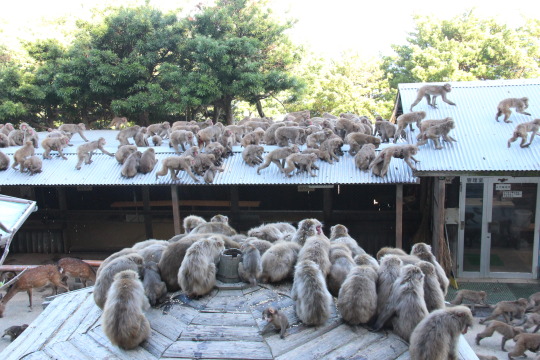
This past summer, I had the opportunity to travel to Awajishima, a small island in Japan, in order to study the behaviour of Japanese macaques (Macaca fuscata) for my PhD research. This monkey population is free-ranging, which means that they are fed at the Awajishima Monkey Center (AMC) but can come and go as they please. The AMC is fairly secluded; it is located on the coast a little way up a mountain surrounded by continued steep mountain slopes and covered in lush forest, unencumbered by people.
My research focused on the movement patterns of a sample group of 22 focal monkeys. For data collection, I followed individual monkeys and recorded all their behaviours in a 35-minute timeframe. I absolutely loved observing the monkeys and found data collection fascinating! When I first arrived, it seemed impossible to spot certain individuals in the overwhelming population of 400 monkeys. However, I was eventually able to pick out the focal monkeys in my study from large groups and from far away, solely based on their particular walks or mannerisms. With time, I began to notice their distinctive personalities. I grew fond of all of them, and of my daily exploration of the AMC and the surrounding forest. Nevertheless, there was one aspect that I despised… the deer.
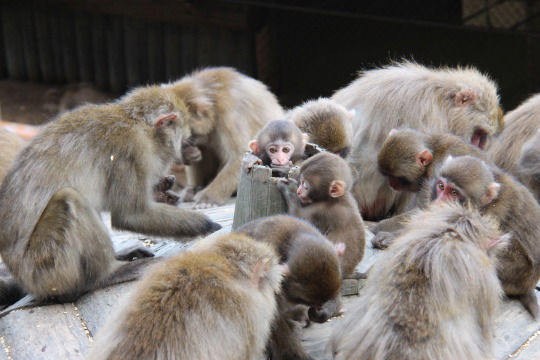
I have always felt a strong connection to most animals. I experience an overwhelming feeling of love for almost all living creatures and have even dedicated my life to studying animal behaviour and to working in animal conservation. Coming from Canada, I had seen wild deer before. It was always at a distance, a fleeting glimpse of an individual in the woods between two trees or of a small family grazing in a field. In these short moments, I would stop and quietly behold the deer in all of its majesty, all the while thinking it was unequivocally a beautiful and gentle creature. However, after putting up with the hordes of deer that occupy the AMC and the neighbouring forest, I have changed my mind.
Upon first arriving, I was surprised by the number of wild deer that voluntarily remain at the AMC. The reason for this soon became clear; the deer eat all of the monkey poop. With such a large and well-fed monkey population, this means an abundance of readily available and “fresh” food. They also eat most of the compost and leftover food that the monkeys do not eat, from banana peels to rotten peanuts. The deer act as big, bulky vacuum cleaners that awkwardly walk around shoving monkeys to clear their paths. If they just cleaned everything up and left the area clear of waste, then maybe I would not have minded them. Unfortunately, they dispensed piles of spherical droppings in their wake.

It is clear that the deer are not threatened or concerned with the monkeys. The deer are much larger and tend to walk straight towards the monkeys knowing that the latter will move out of their way. If the deer senses that there is food in the monkey’s hand, it will try to steal it without hesitation. This became very annoying while I was trying to record the monkey’s behaviour. I would be observing my focal animal during the 35-minute sample, and a deer would just bulldoze into the group of monkeys causing them to scatter. Sometimes my focal monkey would run into the forest, up into the tall trees or on a roof, making it more difficult to accurately record its behaviour and sometimes causing me to lose the sample entirely. Other times, the deer would unknowingly stand in my field of vision forcing me to manoeuvre around them in order to keep recording data.
That being said, not all monkeys immediately ran away. Some would stand their ground and show the deer their long canine teeth. This action is called an “open mouth threat” and is used to tell the other monkeys to back down because they are willing to fight. Unfortunately, the deer do not speak “monkey” and so they do not understand this warning. When that was the case, the deer kept moving towards them and some monkeys would punch the deer in the face! The male monkeys seemed to punch the deer more often than the females. These quick monkey fist jabs were entertaining to watch. Nonetheless, these punches did not seem to faze the deer very much. Even when the impact looked like it was painful, the deer remained where they were and continue to bother the monkeys.
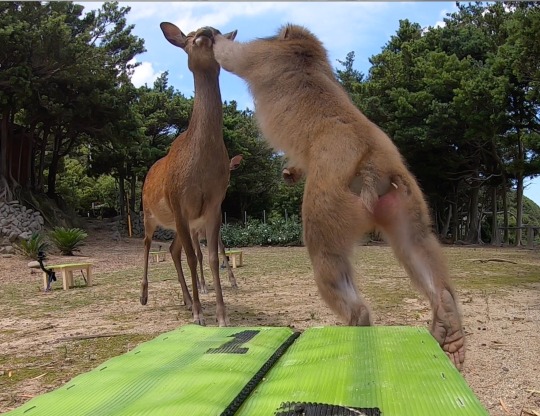
There were some very comical instances when the monkeys would jump onto the deer’s backs. They would either jump on them for a short instance or even ride them for a brief period of time. The monkeys would also sometimes use the deer as a sort of backboard. They would jump and bounce off of the side of the deer’s large body to get onto a tree or higher level.
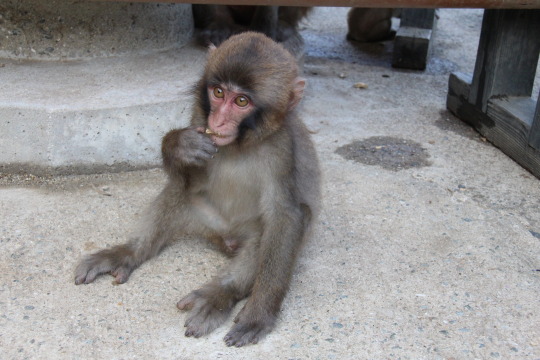
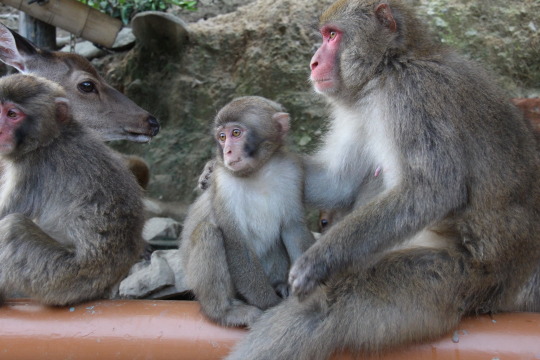
During a particularly hot yet beautiful afternoon, I was sitting in the shade of the forest on the mountain slope recording the behaviour of one of my focal monkeys. He was approximately eight meters away from me, laying on the ground while another monkey groomed him. On the opposite side, equidistant from me was a deer also sitting in the cool shade. As I was observing my focal monkey, I noticed a small young monkey coming over the mountain ridge. He grabbed my attention because it looked as though he were limping. Japanese macaques walk on all fours, however this monkey was using his two legs and one arm. As he was coming closer, I noticed that his strange walk was due to the fact that he was carrying a large rock which was almost the size of his head! As my focal animal was not very active at this time, I was able to watch this little monkey carry the rock all the way across the mountainside and past where I was sitting. The juvenile monkey then started climbing up a tree while still managing to carry the large rock! Because I was in the middle of a sample, I had to revert my attention back to my focal monkey and ended up losing track of where the rock-carrying monkey had gone. All of a sudden, I heard a “THUMP!”. The rock had fallen to the ground and had landed about a half meter away from the deer! The deer got startled, and awkwardly shot up and ran away. As someone who studies animal behaviour, I know that I am not supposed to assume the animal’s intention. However, there is a part of me that really loves the idea that the little monkey tried to drop a rock on the deer!

Brogan Stewart is a PhD student at Concordia University in Montreal, under the supervision of Dr. Sarah E. Turner in the PRIMATE laboratory. Her interests extend to all aspects of ecology, animal behaviour and earth science, but in particular, to maintaining biodiversity and to the conservation of plants and animals. Her graduate research focuses on non-human primate behavioural ecology, with the overarching theme of animal behaviour complexity.

0 Comments